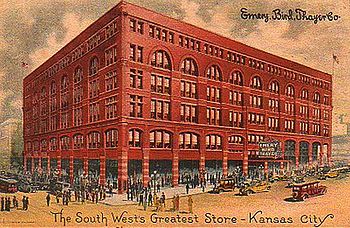
Emery, Bird, Thayer Dry Goods Company
Encyclopedia

Department store
A department store is a retail establishment which satisfies a wide range of the consumer's personal and residential durable goods product needs; and at the same time offering the consumer a choice of multiple merchandise lines, at variable price points, in all product categories...
in Downtown Kansas City
Downtown Kansas City
Downtown Kansas City is the central business district of Kansas City, Missouri and the Kansas City Metropolitan Area. It is located between the Missouri River in the north, to 31st Street in the south; and from the Kansas–Missouri state line east to Troost Avenue as defined by officials of the...
that traced its history nearly to the city's origins as Westport Landing.
The store, known as EBT, closed in 1968, and its building, which was on the National Register of Historic Places
National Register of Historic Places
The National Register of Historic Places is the United States government's official list of districts, sites, buildings, structures, and objects deemed worthy of preservation...
, was torn down in 1971.
The store was started by Kersey Coates
Kersey Coates
Kersey Coates was a Kansas City, Missouri businessman who developed Quality Hill, founded the Kansas City Board of Trade, and one of the businessmen who attracted the Hannibal & St. Joseph Railroad to the city....
and William Gillis in the 1860s in the then Town of Kansas at the corner of Missouri Avenue and Main Street. Although initially outfitting travelers on the Oregon Trail
Oregon Trail
The Oregon Trail is a historic east-west wagon route that connected the Missouri River to valleys in Oregon and locations in between.After 1840 steam-powered riverboats and steamboats traversing up and down the Ohio, Mississippi and Missouri rivers sped settlement and development in the flat...
and Santa Fe Trail
Santa Fe Trail
The Santa Fe Trail was a 19th-century transportation route through central North America that connected Missouri with Santa Fe, New Mexico. Pioneered in 1822 by William Becknell, it served as a vital commercial and military highway until the introduction of the railroad to Santa Fe in 1880...
, it soon became more upscale. It moved to a new three-story building at Seventh and Main.
The original Coates and Gillis store became Coates and Bullene when it merged with a store operated by Thomas B. Bullene
Thomas B. Bullene
Thomas B. Bullene was mayor of Kansas City, Missouri in 1882.Bullene was born in Oswego County, New York. He was an owner of the Emery, Bird, Thayer & Co...
. It then became the Bullene, Moore and Emery department store. The store assumed its final name in the 1890s from the investors W. E. Emery, Joseph Taylor Bird. Sr. and William B. Thayer.
In the 1890s it opened a new building occupying a full block along East 11th Street from Walnut to Grand, designed by the architectural firm of Van Brunt & Howe. It soon became the prime attraction on the city's main retail thoroughfare, popularly known as "Petticoat Lane," and became famed for its Tea Room.
Although the store attempted to expand, opening a branch on the Country Club Plaza
Country Club Plaza
The Country Club Plaza is an upscale shopping district and residential neighborhood in Kansas City, Missouri, USA. It was the first shopping center in the world designed to accommodate shoppers arriving by automobile...
in 1925 (enlarged in 1963) and purchasing the Bundschu store on the courthouse square in Independence
Independence, Missouri
Independence is the fourth largest city in the U.S. state of Missouri, and is contained within the counties of Jackson and Clay. It is part of the Kansas City Metropolitan Area...
, it could not keep pace with changing retail fashions and settlement patterns, and in 1968 it closed, with the loss of 800 jobs.
A restaurant called EBT, at 103d Street and State Line Road near I-435, currently houses memorabilia from the store. The firm's warehouse at 16th and Walnut has been converted into residential lofts. During the renovation, lettering on the side of the warehouse reading "Emery Bird Thayer Warehouse" was repainted.

